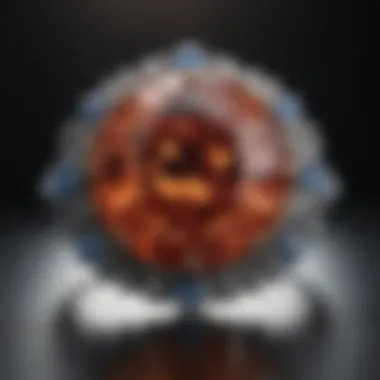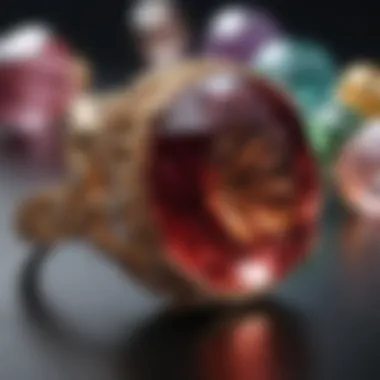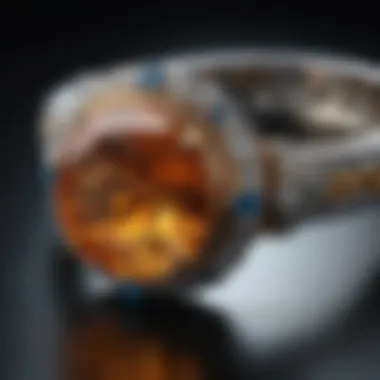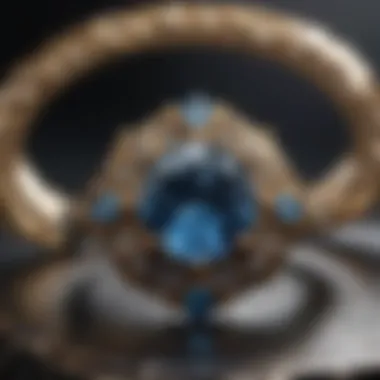Unveiling the Factors Influencing the Selling Price of Jewelry


Overview of Gemstones and Minerals
Gemstones and minerals have played a pivotal role in human history and culture. Dating back to ancient civilizations, these precious stones have been highly coveted for their beauty and rarity. Overtime, gemstones gained symbolic significance in various societies, representing power, status, and spiritual beliefs. The allure of gemstones transcends mere aesthetics; they hold a profound cultural and societal significance that continues to fascinate enthusiasts and collectors alike. The intricate history and cultural significance of gemstones set the stage for understanding the complexities of valuing and selling jewelry.
Gemstone Formation and Properties
The formation of gemstones is a fascinating process that takes millions of years to complete. Through a series of geological events such as heat, pressure, and mineral interactions, gemstones gradually crystallize and develop their unique properties. These properties, including color, hardness, and luster, distinguish one gemstone from another. Gemstones are categorized based on these defining properties, each classification revealing the remarkable diversity and inherent beauty of these natural treasures.
Types of Gemstones
Gemstones can be broadly categorized as precious or semi-precious, with each category encompassing a wide range of varieties. Precious gemstones, such as diamonds, rubies, sapphires, and emeralds, are highly sought after for their rarity and exceptional beauty. Conversely, semi-precious gemstones like amethyst, citrine, and turquoise offer a vibrant spectrum of colors and affordability. In addition to these common varieties, there exist exotic and rare gemstones that captivate collectors with their exceptional properties and scarcity.
Identifying and Evaluating Gemstones
When assessing the value of gemstones, multiple factors come into play, influencing their market price and desirability. From the carat weight to the clarity and cut of the gemstone, various criteria determine its overall value. Gemologists employ specialized techniques to accurately identify gemstones, utilizing tools like refractometers and spectroscopes to assess their quality and authenticity. Evaluating gemstones requires a keen eye for detail and an understanding of the factors that contribute to their allure.
Caring for Gemstones
Properly caring for gemstones is essential to maintain their brilliance and longevity. Regular cleaning and appropriate storage can prolong the lifespan of gemstone jewelry, preserving its beauty for generations to come. Avoiding common mistakes, such as exposing gemstones to harsh chemicals or extreme temperatures, is crucial in safeguarding their integrity. Different gem types may require specific preservation techniques to prevent damage and ensure their durability over time.
Understanding the Value of Jewelry
In the realm of evaluating jewelry, a profound understanding of its value is paramount. This section delves into the multifaceted aspects that determine the price you can sell your jewelry for. By dissecting the materials used, the intricacy of design, and the significance of brand recognition, readers will grasp the nuanced factors at play when assessing the worth of their prized possessions.
Materials Used in the Jewelry
Precious Metals
When it comes to jewelry, precious metals stand as the epitome of elegance and value. Their role in determining the overall allure and cost of jewelry is immense. Gold, silver, and platinum showcase durability and timeless appeal, making them highly sought-after in the market. The unique feature of precious metals lies in their ability to retain value over time, serving as a lucrative choice for individuals looking to maximize returns.
Gemstones
Gemstones add a touch of glamour and sophistication to jewelry pieces, elevating their aesthetic appeal. From dazzling diamonds to vibrant rubies, each gemstone carries its distinct allure and symbolism. Their rarity and exquisite beauty contribute significantly to the overall value of jewelry, making them a popular choice among connoisseurs and collectors. However, the rarity of some gemstones also poses challenges in terms of sourcing and pricing, demanding thorough consideration in valuation processes.


Other Materials
Beyond precious metals and gemstones, jewelry often incorporates a myriad of other materials to enhance its design and character. From pearls to enamel, these materials play a crucial role in adding texture and uniqueness to jewelry pieces. While alternative materials offer versatility and artistic freedom, they may come with diverse advantages and disadvantages in terms of durability and market desirability. Understanding the interplay of various materials is essential in accurately assessing the overall value of jewelry pieces.
Design and Craftsmanship
Craftsmanship contributes significantly to the allure of jewelry, underscoring the importance of intricate design and skilled artistry. The intricacy of design reflects the dedication and precision invested in creating a piece of jewelry, amplifying its visual appeal and perceived value. Each minute detail crafted with care enriches the overall aesthetics, making the piece truly distinct and covetable.
Artistic value further enhances the significance of jewelry pieces, infusing them with creativity and innovation. Artists and designers channel their expertise into shaping unique and expressive pieces that resonate with individuality and style. The artistic value of jewelry transcends mere adornment, embodying stories, emotions, and cultural inspirations, drawing admirers into a realm of beauty and imagination.
Expertise of craftsmanship is a hallmark of exceptional jewelry, highlighting the mastery and skill of artisans in their craft. Whether through traditional techniques or contemporary approaches, craftsmen showcase their proficiency in bringing intricate designs to life with unparalleled precision and finesse. The expertise behind each piece elevates its value, reflecting a harmonious blend of creativity and technical prowess.
Brand Recognition and Reputation
A jewelry brand's reputation holds immense sway in determining the perceived value and desirability of its creations. Luxury brands command attention and respect in the market, symbolizing exclusivity and exceptional quality. The prestige associated with luxury brands not only enhances the perceived value of jewelry pieces but also signifies a commitment to superior craftsmanship and design excellence.
Independent designers bring a fresh and innovative perspective to the world of jewelry, infusing their creations with individuality and artistry. Their unique approach fosters authenticity and originality, appealing to discerning individuals seeking distinctive pieces that tell a story. The allure of independent designers lies in their capacity to push boundaries and offer fresh interpretations of beauty and style.
Historical significance adds a layer of depth and intrigue to jewelry pieces, bearing testament to their cultural and artistic legacy. Jewelry with historical significance carries a rich narrative and heritage, resonating with collectors and enthusiasts appreciative of its unique backstory. The historical context enriches the value of jewelry, imbuing it with a sense of timelessness and cultural resonance, making it a prized asset in any collection.
Market Factors Influencing Jewelry Pricing
In the realm of fine jewelry, the awareness of market factors governing pricing is paramount. Understanding the pulse of the market helps in gauging the value of jewelry pieces accurately. Market dynamics play a pivotal role in influencing the desirability and valuation of jewelry. Factors such as current trends, demand variations, and economic conditions directly impact the pricing strategies adopted by sellers and buyers alike. Whether you are a seasoned collector or new to the world of gemstones, comprehending these market forces is key to making informed decisions when selling your jewelry.
Current Market Trends
Popularity of Styles
The popularity of styles in jewelry sets the tone for consumer preferences and market demand. Certain designs may capture the zeitgeist, becoming highly sought after and commanding premium prices. Understanding the popular styles allows sellers to align their offerings with current trends, ensuring relevance and competitiveness in the market. While classic designs retain timeless appeal, staying attuned to evolving tastes ensures continued interest and value in jewelry pieces.
Seasonal Variations
Seasonal variations play a significant role in shaping jewelry trends. Different seasons bring forth distinct fashion sensibilities and color palettes, impacting the choice of jewelry pieces. For instance, vibrant hues may dominate summer collections, while winter styles may veer towards rich, opulent designs. Adapting to seasonal trends enables sellers to cater to seasonal demands effectively, maximizing sales opportunities and aligning with consumer preferences.
Fashion Trends


Fashion trends exert a profound influence on the jewelry industry, dictating the evolution of styles and preferences. In a dynamic fashion landscape, jewelry designers respond to shifting trends by incorporating innovative elements and materials into their creations. Staying abreast of fashion trends allows sellers to showcase trendy pieces that resonate with fashion-conscious buyers, enhancing desirability and valuation in the market.
Demand and Scarcity
Limited Edition Pieces
Limited edition pieces hold a special allure for collectors and enthusiasts, offering exclusivity and rarity. Limited production runs create scarcity, driving up the perceived value of such pieces in the market. Owning a limited edition jewelry piece not only reflects individuality but also signifies an investment in a coveted item with enduring value potential.
Vintage or Antique Jewelry
Vintage and antique jewelry pieces convey a sense of history and nostalgia, appealing to connoisseurs who appreciate the craftsmanship and beauty of bygone eras. The scarcity of authentic vintage and antique jewelry contributes to their rarity and desirability among collectors. Owning a piece of vintage jewelry adds a touch of elegance and heritage to any collection, making it a prized possession with timeless allure.
Culturally Significant Pieces
Culturally significant jewelry pieces hold intrinsic value beyond their aesthetic appeal, embodying heritage and tradition. Jewelry that holds cultural significance often features symbolic motifs and designs that resonate with specific communities or histories. Acquiring culturally significant pieces not only enriches one's collection but also celebrates diversity and craftsmanship, fostering a deeper appreciation for the artistry and cultural heritage encapsulated in each piece.
Economic Factors
Inflation
The impact of inflation on jewelry pricing underscores the need for continuous assessment of pricing strategies in response to economic fluctuations. Inflationary pressures can drive up material costs and production expenses, influencing the final pricing of jewelry pieces. Understanding the inflationary landscape is crucial for maintaining pricing competitiveness and adjusting strategies to navigate the evolving economic climate effectively.
Currency Exchange Rates
Currency exchange rates play a pivotal role in the global jewelry market, affecting international trade and pricing dynamics. Fluctuations in exchange rates can impact the cost of materials, production, and transportation, thereby influencing the overall pricing of jewelry pieces. Monitoring currency exchange rates and their impact on pricing is essential for sellers operating in international markets to mitigate risks and optimize profitability.
Global Economic Conditions
Global economic conditions encompass a broad spectrum of factors that can directly or indirectly influence jewelry pricing. Economic uncertainties, geopolitical events, and trade policies all contribute to the volatility and unpredictability in the jewelry market. Adapting to global economic conditions requires agility and strategic decision-making to navigate challenges and leverage opportunities in a dynamic marketplace.
Assessing Jewelry Resale Value
When delving into the realm of jewelry resale, a crucial aspect to consider is assessing the value that your precious pieces hold. Understanding the resale worth of jewelry involves a meticulous evaluation of various factors that can influence its pricing. By comprehensively assessing the resale value of your jewelry, you can make informed decisions regarding its potential selling price, maximizing your returns with strategic insights. Assessing jewelry resale value is not merely about determining the monetary worth of your pieces but also about appreciating the craftsmanship, historical significance, and market demand that contribute to their overall value.


Quality and Condition
Purity of Materials
In the realm of jewelry, the purity of materials used holds paramount importance in determining the quality and value of a piece. Materials like gold, silver, platinum, or other precious metals are prized for their purity levels, which directly impact their worth in the market. The higher the purity of these materials, the more valuable the jewelry piece becomes due to its inherent rarity and quality. Opting for materials with high purity ensures durability, luster, and a timeless appeal, making them sought-after choices for those looking to invest in exquisite jewelry pieces.
Damage or Wear
When evaluating jewelry, the presence of damage or signs of wear plays a significant role in determining its resale value. Damage, such as scratches, dents, or missing stones, can greatly diminish the overall appeal and worth of a piece. Similarly, noticeable wear from regular use can detract from the aesthetic and functional aspects of jewelry, lowering its perceived value in the eyes of potential buyers. To maintain a higher resale value for your jewelry, it is imperative to address any damage or wear promptly through professional restoration or repair services.
Certificate of Authenticity
A certificate of authenticity is a vital component in verifying the legitimacy and value of jewelry pieces, especially when it comes to rare or high-end items. This official document serves as a guarantee of the jewelry's origins, materials used, and quality standards, instilling confidence in potential buyers regarding the item's authenticity. Possessing a certificate of authenticity not only enhances the resale value of your jewelry but also provides buyers with assurance regarding the piece's intrinsic worth and provenance, making it a crucial element in the resale process.
Historical Significance
Provenance
The provenance of a piece of jewelry refers to its documented history of ownership, which can significantly enhance its value and desirability in the resale market. Jewelry with a prestigious or noteworthy provenance attributed to renowned designers, historical figures, or significant occasions holds a special allure for collectors and enthusiasts. Provenance adds a layer of authenticity and interest to jewelry pieces, offering buyers a tangible connection to the past and elevating the overall appeal and value of the item.
Previous Ownership
The concept of previous ownership plays a crucial role in shaping the narrative and value of jewelry pieces, particularly those with a rich history or celebrity connections. Jewelry previously owned by famous personalities, royal figures, or esteemed individuals carries a unique allure that resonates with collectors and enthusiasts seeking pieces with a compelling backstory. The prestige associated with previous ownership elevates the desirability and resale value of jewelry, making it a coveted choice for those looking to invest in pieces with a touch of glamour and legacy.
Cultural or Artistic Importance
Jewelry pieces embody cultural and artistic significance, reflecting specific traditions, aesthetics, or historical periods that contribute to their value and appeal. Pieces that showcase intricate craftsmanship, unique design elements, or symbolic motifs often hold cultural or artistic importance beyond their material worth. This intrinsic value stemming from cultural references or artistic narratives adds depth and meaning to jewelry pieces, making them more than adornments but also vessels of heritage and creativity that resonate with collectors and connoisseurs.
Professional Appraisal and Evaluation
Appraisal Process
The appraisal process is a fundamental step in determining the true value of jewelry, involving thorough inspection, analysis, and documentation by certified appraisers. Through a detailed appraisal, the quality, craftsmanship, materials, and overall worth of a jewelry piece are assessed, providing an accurate estimation of its market value. Professional appraisals offer transparency and credibility in showcasing the authenticity and value of jewelry, essential for making informed decisions regarding selling, insuring, or investing in valuable pieces.
Authentication Services
Authentication services play a pivotal role in verifying the legitimacy and intrinsic worth of jewelry, especially for rare, antique, or high-value items. By utilizing authentication services provided by accredited organizations or experts, the authenticity and unique characteristics of jewelry pieces can be confirmed, instilling confidence in buyers and collectors. Authentication enhances the credibility and value of jewelry, safeguarding against counterfeits and ensuring that buyers are investing in genuine and valuable pieces.
Market Research
Conducting thorough market research is essential for understanding current trends, demand patterns, and pricing fluctuations in the jewelry industry. By staying informed about market dynamics, consumer preferences, and competitor offerings, sellers can strategically position their jewelry for maximum impact and profitability. Market research enables sellers to identify niche markets, anticipate demand shifts, and set competitive prices based on value propositions and market positioning, empowering them to make informed decisions that optimize the resale value of their jewelry pieces.







